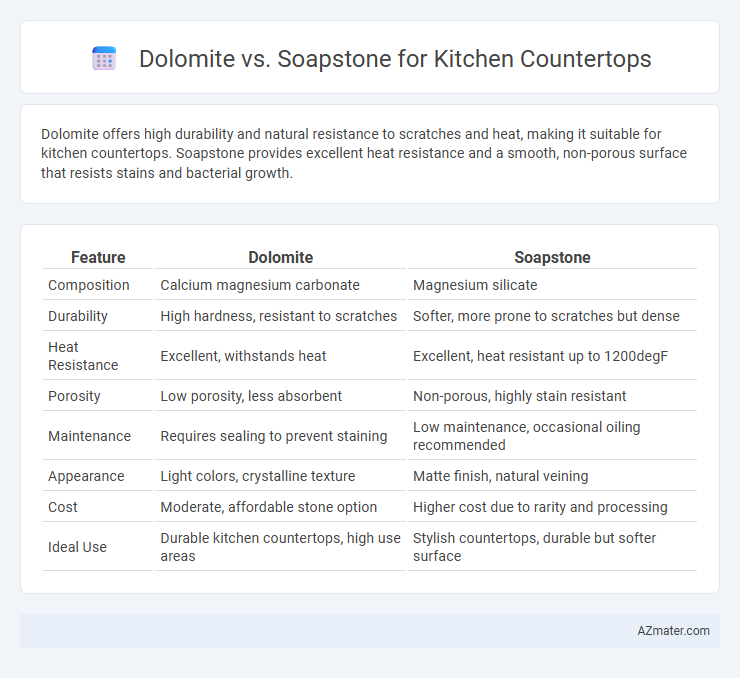Dolomite offers high durability and natural resistance to scratches and heat, making it suitable for kitchen countertops. Soapstone provides excellent heat resistance and a smooth, non-porous surface that resists stains and bacterial growth.
Table of Comparison
| Feature | Dolomite | Soapstone |
|---|---|---|
| Composition | Calcium magnesium carbonate | Magnesium silicate |
| Durability | High hardness, resistant to scratches | Softer, more prone to scratches but dense |
| Heat Resistance | Excellent, withstands heat | Excellent, heat resistant up to 1200degF |
| Porosity | Low porosity, less absorbent | Non-porous, highly stain resistant |
| Maintenance | Requires sealing to prevent staining | Low maintenance, occasional oiling recommended |
| Appearance | Light colors, crystalline texture | Matte finish, natural veining |
| Cost | Moderate, affordable stone option | Higher cost due to rarity and processing |
| Ideal Use | Durable kitchen countertops, high use areas | Stylish countertops, durable but softer surface |
Introduction to Dolomite and Soapstone Countertops
Dolomite countertops, composed primarily of calcium magnesium carbonate, offer a durable and visually appealing surface with a natural marble-like appearance, resistant to scratches and heat. Soapstone countertops, made from talc-rich metamorphic rock, are valued for their smooth texture, high resistance to heat and stains, and unique aging process that develops a rich patina over time. Both materials provide excellent options for kitchen countertops, balancing aesthetics with practical durability.
Key Differences Between Dolomite and Soapstone
Dolomite countertops offer a harder and more scratch-resistant surface compared to soapstone, which is softer and easier to etch but highly resistant to stains and heat. Soapstone provides a unique smooth texture and natural color variations, while dolomite features a crystalline structure with more pronounced veining and a glossier finish. Maintenance differs as soapstone requires periodic oiling to enhance its patina, whereas dolomite is generally sealed to protect against moisture and staining.
Appearance and Aesthetic Qualities
Dolomite countertops offer a sleek, crystalline appearance with a mix of white, gray, and green hues that create a subtle yet elegant look ideal for modern kitchens. Soapstone features a smooth, matte surface with deep, dark tones ranging from soft gray to almost black, accented by natural veining that gives a timeless, rustic charm. Both materials provide unique aesthetic qualities, with dolomite lending a brighter, more polished finish and soapstone delivering a warm, classic ambiance perfect for various kitchen designs.
Durability and Strength Comparison
Dolomite countertops offer strong resistance to scratches and heat, making them a durable option for kitchen surfaces. Soapstone, although softer and more prone to scratches, is highly resistant to heat and chemical stains, maintaining its structural integrity over time. Both materials provide longevity, but dolomite's greater hardness results in superior strength, while soapstone's thermal stability and non-porous nature offer enhanced durability in specific kitchen environments.
Heat and Stain Resistance
Dolomite countertops exhibit moderate heat resistance, tolerating temperatures up to 400degF but are more porous, making them susceptible to staining without proper sealing. Soapstone offers superior heat resistance, handling direct contact with hot pots and pans without damage, and its dense, non-porous surface provides excellent stain resistance. Both materials require routine maintenance, but soapstone's natural oils help prevent stains, making it a preferred choice for heat and stain durability in kitchen countertops.
Maintenance and Care Requirements
Dolomite countertops demand regular sealing to prevent staining and etching, with daily cleaning using pH-neutral soap recommended to preserve their polished finish. Soapstone offers superior resistance to acids and stains, requiring less frequent sealing--typically once a year--and can be cleaned easily with mild detergent and water. Both materials benefit from prompt spill cleanup, but soapstone's natural patina and softer surface make it more forgiving to minor scratches and everyday wear.
Cost and Value Considerations
Dolomite countertops typically cost between $60 and $120 per square foot, offering excellent durability and a polished appearance that adds long-term value to kitchens. Soapstone, priced around $70 to $130 per square foot, provides superior heat and stain resistance but may require occasional treatment to maintain its look. Choosing between dolomite and soapstone depends on balancing initial investment with maintenance preferences and desired aesthetic, impacting overall kitchen value and functionality.
Environmental Impact and Sustainability
Dolomite countertops offer moderate environmental benefits due to their natural mineral composition and durability, requiring less frequent replacement compared to synthetic options. Soapstone is highly sustainable, as it is a natural, non-toxic material that can be easily repaired and recycled, minimizing environmental waste. Both materials have a lower carbon footprint than engineered stones, but soapstone's longevity and minimal processing make it a more eco-friendly choice for kitchen countertops.
Pros and Cons of Dolomite Countertops
Dolomite countertops offer a durable and visually appealing surface with natural white and gray hues, making them resistant to heat, scratches, and stains, which is ideal for kitchen use. However, dolomite is more porous than soapstone, requiring regular sealing and maintenance to prevent staining and damage from acidic substances. Despite needing upkeep, dolomite provides a harder surface that withstands wear better over time compared to soapstone, making it a preferred choice for longevity in kitchen countertops.
Pros and Cons of Soapstone Countertops
Soapstone countertops are highly durable and resistant to heat, stains, and acids, making them ideal for kitchen use. Their natural smooth texture and ability to develop a unique patina over time add aesthetic value but require regular oiling to maintain appearance. However, soapstone is softer than dolomite, which makes it more prone to scratches and dents, potentially necessitating repairs or refinishing.

Infographic: Dolomite vs Soapstone for Kitchen Countertop
 azmater.com
azmater.com